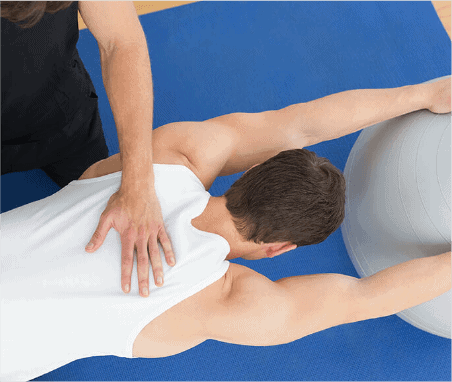Corrective movement therapy in Corte Madera, CA, Marin County.
Corrective Movement Therapy
Re-train your movement patterns to bring
lasting relief to acute and chronic
pain.

Corrective Movement Therapy
Corrective Movement Therapy
For sudden and persistent pains from:
- Tense and painful muscles triggered by emotional stress
- Working from home with poor ergonomics (neck, shoulder, wrists and back pain)
- Muscle pulls, strains and other sports injuries
What happens during a typical Corrective Movement Therapy in-office 50-minute Session?
Clients wear comfortable workout clothes for their sessions. After that, the intake session will include a thorough review of your medical history and an assessment of your muscles and other tissues’ health. Also, during a session, corrective movement therapy is combined with other techniques. Therefore, the aim is to use precise muscle tests to measure the function of each muscle or muscle group. The muscle tests measure function, not strength, so the test feels like the resistance of a light exercise band. Your therapist will put your body in different positions and then ask you to resist pressure using specific movements.
After identifying the compensation patterns that the muscles are displaying, specific muscles are released. To release/relax a muscle, your therapist puts pressure on the tight area using fingers, an elbow, or a special tool. When needed, the therapist will give corrective exercises to do at home that will reinforce the new movement pattern. The therapist will ask you for feedback during each release to make sure that the release is not uncomfortable.
Rather than being a complete therapy on its own, Corrective Movement Therapy is most often used as a tool to enhance the effectiveness of other treatments. Additionally, Corrective Movement Therapy is an excellent tool for finding the compensation patterns that are causing pain. Finally, the precise muscle tests can take some of the mystery out of the “Why” of persistent injuries and pain patterns by mapping out and correcting dysfunctional movement patterns that were the result of muscle compensation.
Fee structure:
Corrective Movement Therapy – $240 per 50-minute session. Corrective movement therapy is a form of neuromuscular therapy and is scheduled as a 50-minute Neuromuscular Therapy session.
Would you like to know if Corrective Movement Therapy can help you? Email me at [email protected] to schedule a free 15-minute ZOOM consult.
What is Corrective Movement Therapy?
“Corrective Movement Therapy” is a group of therapies based on the current scientific understanding of how our nervous system learns to produce, refine, and remember movement patterns. Therefore, when this system is examined and treated by a qualified therapist, fast and long-lasting changes which can then correct pain and injury-causing patterns. The result is the ease of movement restrictions and pain levels.
How does the Corrective Movement Therapy work?
The Motor Control Center (MCC) is a section of the brain responsible for creating and storing conscious and unconscious movement patterns and is made of two kinds of movement systems in mammals: the hard motor and the soft motor systems.
Firstly, the hard motor system includes body movements that come “pre-installed” at birth. Therefore, think of a nature program on TV that shows a mother deer giving birth to a faun. As a result of this system, fauns can stand within 10 minutes, walk in 7 minutes, and run in about three months which is very different than the soft motor system in humans and apes.
Secondly, the soft motor system is one in which there are no pre-programmed movements available at birth. Therefore, all motions are learned by trial and error. For example, a human baby starts crawling between 7-10 months, walks without support at around 12 months, starts running and jumping at two years, and can usually hop and skip by their 5th year.
Moreover, both of these systems have advantages. For deer, gazelles, or antelopes, being able to walk and run soon after birth helps them avoid predators and, for some animals, keep up with the herd.
The evolutionary trade-off
With humans and apes, the evolutionary trade-off means a more extended period of dependence on parental care before the child becomes independent in exchange for being more adaptable when injured.
If a deer pulls a hamstring when a pack of wolves is chasing it, it will go lame and most likely become a victim of its predator. If a human is trying to escape from a tiger and pulls a hamstring, the MCC soft system will compensate by immediately recruiting other muscles to take over. The injured human may not even feel pain in the damaged area for 1-3 days after the injury.
In humans, our MCC is continuously looking for ways to refine movement. The goal is to optimize how we move to save energy and to avoid injury.
However, various problems may arise after an injury has healed, and our brains and bodies are unable to unlearn the compensation patterns. The compensation was necessary during the injury, but if not corrected after the injury has healed, this pattern can cause significant problems.
Our MCC is still an evolutionary work in progress; sometimes, it needs help finding its way back to efficient pain-free movement. In many cases, people will have persistent pain in part because of a movement pattern leftover from a previous injury.
I have certifications in two versions of this therapy: The Nemerov Method and Neurokinetic Therapy.
